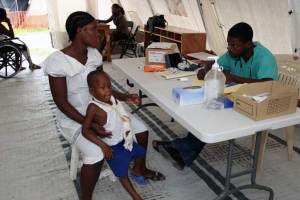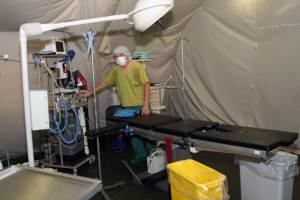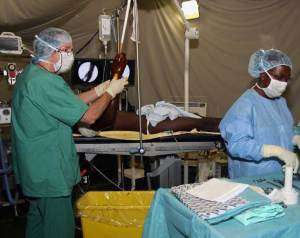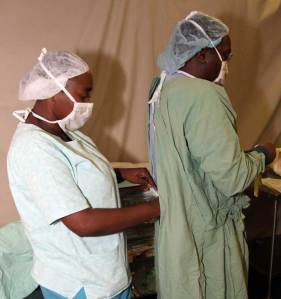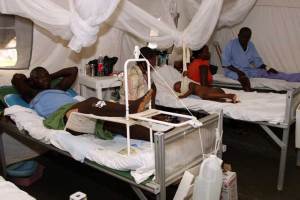Hopital St. Louis
I had tried repeatedly to schedule a meeting with Medecins Sans Frontieres (Doctors Without Borders), winner of the 1999 Nobel Peace Prize, through its press office in Port au Prince, but without success. My phone calls weren’t returned, my emails weren’t answered. So, when I saw the sign tacked to an electric power pole, Hopital St. Louis Centre de Sante, Delmas 31, with the MSF logo in the upper left corner, I was inspired to the journalist’s last resort, the drop-in visit.
My driver, Charles, a middle aged Haitian who speaks barely adequate English, said “Hopital St. Louis,” pointing to our right as we drove past a well fortified and guarded gate. He turned through the next gate we came to, this one open, into the parking lot of a radio station next door. As he stopped the car, we could see several men hanging out in the shade of a blue plastic tarp at the end of the parking lot, and beyond them, a low wall with a four or five foot wide gap in it. “Hospital,” Charles said, pointing straight ahead.
Seeing no particular reason to go to the front gate when this less bureaucratic option was available, I exited the car and made for the gap. Once through, I saw a row of large U.N. provided tents in which classes seemed to be in session. Turning right, I walked along the length of the tents toward a large building on my left that I assumed to be the hospital. I came to an intersection with the parking lot in front of the building and said “Hopital?” to a young Haitian man passing by. He led me past the front of the building I thought was the hospital and pointed me to a muddy path just past it to our left.
Taking this through relatively open ground dotted with a few tents, I arrived within a quarter mile or so at a road thickly lined on both sides with them. Just a short walk down this road I came to the actual gate of Hopital St. Louis. A group of Haitians was milling around in front and I slipped through them and caught the eye of the armed security guard inside, which wasn’t difficult given the circumstances. Through the gate, I handed him my letter from the Observer and after looking at it briefly, he let me in. He pointed me to a bench and handed the letter to another young man who disappeared into the compound. Within ten minutes, a tall, slender, comely young woman approached.
“Hello, how may I help you?” she asked in lightly French accented English.
I explained that I would like to speak to someone about documenting MSF’s work at the hospital and she replied, “Well, that would be me. I have something I have to attend to, but if you will please wait here I will be back in a few minutes.” Good as her word, she returned shortly and led me into the grounds. Her name is Michele. As we approached the first tent, Triage, or Intake, Michele explained the ground rule.
“We have one basic rule here and that is that you must get permission to photograph people. This is to protect both their dignity and their security. There is a lot of kidnapping here and some people, patients and local staff, are concerned that if their pictures are seen in association with an aid organization it might make them a target.”
Entering the triage tent, we found a young male Haitian staff member recording information from a young woman and her son, a boy of probably five or six whose left arm was in a sling. I asked if I could take a picture and after Michele passed along my request, permission was granted. I shot a couple of frames and we moved on to the surgical wing.
We entered through the recovery room, a large, un-air conditioned tent perhaps 50 feet by 50 feet, where several patients were lying on gurneys, some conscious, some semi-so. Michele again left me momentarily, disappearing into the operating theater. She soon returned with a surgeon in scrubs who looked to be in his late 50’s or early 60’s. He introduced himself as Richard, in what sounded to me like a French accent, and asked if I would like to see an operating room, to which I replied, naturally, in the affirmative.
He led me down a short hall and unzipped a door to an unoccupied operating room on our left. This room was probably a little smaller than the recovery room, and air conditioned. Not being particularly familiar with operating rooms, I can’t say for certain, but it looked to me to be outfitted with pretty much the basics; a padded, adjustable table for the patient to lie on, patient monitoring equipment, a large overhead light and a couple of stands from which to hang bags of fluids to be administered intravenously. With Richard’s permission, I shot a few pictures before we stepped back into the hall.
The operating room we had just exited was a general surgery operating room. Across the hall was an orthopedic operating room the door of which Richard zipped open to reveal a surgery about to begin. A Haitian man lay naked, except for his hospital gown covering his groin, on the operating table, his right arm suspended vertically by a narrow cloth band attached to his middle finger. Two circular X-rays of his damaged arm, which revealed nothing to me, were visible beyond him hanging at eye level.
As I watched, two nurses arranged instruments on a table and the surgeon swabbed the patient’s hand and lower arm with iodine colored disinfectant. Given the okay to photograph, everyone’s face was largely obscured, the doctor’s and nurses’ by their masks and the patient’s by his position and the surgeon’s body, I took a half-dozen or so pictures before Richard zipped the room shut and we returned to the recovery room.
Once back in the recovery room, Richard excused himself, but soon returned with another surgeon, saying in an offhand manner as he left again that I could see some his work. At the time, I didn’t quite process what Richard meant, assuming that I would maybe get a look at some patients this new guy had operated on. I asked the new arrival, who’s probably 40 to 45 years old, his name and he said Toussaint Sterman. I then asked if he’s Haitian and he said, in English, that he is. From here I moved on to professional questions.
He said he’s a general surgeon and when I asked the nature of the operations he performs most frequently his answer surprised me. “Mostly car accident related”, he replied. “But accidents of all sorts, as well as a lot of gunshot wounds.” I asked how many a week and he said maybe 50 or so. After about ten minutes, Toussaint stood up to return to the operating theater and motioned me to follow. As we moved into the anteroom between the recovery room and the operating rooms, Michele reappeared.
“Do you want to photograph the operation?” she asked, taking me aback. “If you do, you have to change clothes.”
After thinking it over for about a second, I decided I had to say yes, but not without some trepidation. I’d never photographed actual surgery before and I have been known to faint in medically intense settings.
Michele showed me into the changing room, just to our left, where a set of green scrubs, including hair net, mask and matching green rubber clogs, was laid out. I changed and when I came out a young Haitian, also in scrubs, led me to the operating room I had photographed, sans patient, earlier.
Toussaint, three nurses and the patient, another young Haitian man, were already there. The patient was sitting on the operating table, like the orthopedic patient with his hospital gown across his lap, looking uncomfortable, which made me uncomfortable. I concentrated on the nurses, who were doing something involving a bib like cloth with a hole in it and antiseptic, to the patient’s back. I asked Toussaint if I could take pictures, he asked the nurses and the patient, and the answer came back negative. So I was left to stand around and think of other things besides what was occurring, which, when a syringe with a long needle came into play and the patient grimaced, I realized was the administration of an epidural anesthetic.
Shortly thereafter, the patient lay back, the hospital gown was removed and all was revealed. On his lower abdomen, bulging just to the right of his penis, was a protruding hernia about five inches long and three across. As one nurse assisted Toussaint in getting gowned, the others draped lavender sheets over the patient, leaving only the relevant area exposed. They also rigged a vertical cloth across his upper chest so that he couldn’t see the surgery, as he was conscious, just anesthetized from the waist down.
At this point I was given the all clear to photograph, for which I was grateful, and not just because I was looking forward to taking pictures. As is always the case, once I had the camera to my eye, what was occurring on the other side of it didn’t affect me personally. The second I looked through the viewfinder, any queasiness I’d been feeling vanished.
Toussaint began the operation assisted only by three nurses, but after a while a second surgeon, Philippe, came in. I don’t know if this was because the surgery turned out to be more complex than Toussaint initially thought it would be, or if it was planned that way all along. In any case, I shot a lot of photos, most of which, although some were of cutting, some of pulling and stretching and some of sewing, all look pretty much the same.
I did try to vary them some by climbing on a chair for a while and shooting some close-ups of just hands at work, but there was only so much distinction available. After a half hour or so I felt like I’d gotten enough, given that this wasn’t for a medical textbook, and was actually glad when a young man came in and told me Michele was waiting.
She asked if I’d gotten what I needed and when I said yes, she said fine, I could change back into my clothes. Before I finished, she came to the door and asked if I was okay. I was, and I don’t think I looked otherwise, but maybe she saw something I wasn’t aware of, or maybe she’d just had problems with other photographers fainting on their way out. Or maybe she was just in a hurry, as she told me when I came out that we would have to reschedule the rest of the tour as she had other matters to attend to. “Usually people make an appointment before they come,” she said, perhaps a little pointedly.
We went to her office, passing through the orthopedic ward on the way, and scheduled the remainder of my visit for 9 a.m. the following day, an appointment I would be unable to keep, as it turned out. Unfortunately, it was now pouring rain, Port au Prince catching one of the outer bands of tropical storm Alex passing south of the island of Hispaniola, and I didn’t have any way to protect my camera on the way back to the car. So Michele left me on a bench under the eaves of the tent with Maria, a Swedish anesthesiologist spending her month’s vacation here. She filled me in on the living conditions at Hopital St. Louis.
Everyone sleeps, or tries to, in un-air conditioned tents. She did say she has a tent of her own, however. Most people are up and out by 6 a.m. and the work day usually goes until nine or 10 p.m., after which people may chat for a short while before collapsing into bed. There’s one communal television, but the staff rarely watches it. And for security reasons, no one is allowed to leave the hospital grounds. All in all, not your average Caribbean holiday. But, of course, it’s not intended to be and people come with their eyes wide open and a strong sense of purpose.
Eventually the rain let up some and Maria asked a young doctor if he could get me a plastic bag for my camera. He came back with a plastic sheet that I wrapped it up in. Maria walked me to the gate and when we arrived asked me, with some concern, if I would be okay walking out. I replied, as I always do in these situations, that I would be fine. As a parting thought, she mentioned that it was probably a good thing that I had the camera concealed. Naturally, as I walked up the road, I felt everybody along the way eyeing me, wondering what I was hiding. But I made it out unmolested and found Charles waiting with the car.
